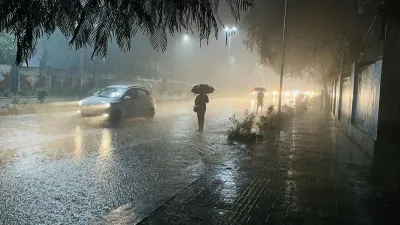Rajasthan Records 285 mm Rainfall—Highest in 69 Years
aRecord rainfall, flooding, district impact
- July 2025 brought unprecedented rains across Rajasthan, marking the highest monthly rainfall in 69 years, with widespread flooding that engulfed roads and submerged towns.
- Dholpur’s Chambal River rose to about 12 meters above danger mark, prompting opening of Parvati Dam gates four times this season, including one discharge of 4,401 cusecs at 6:30 pm near Angai village.
- Emergency operations involved deployment of the army and State Disaster Response Force (SDRF) to aid rescue and relief efforts.
b) Scale of excess rainfall & water infrastructure
- From June 1 to July 29, Rajasthan received 374.58 mm, nearly 85 % higher than the normal 202.51 mm for this period.
- According to government figures, 226 out of 693 dams in the state have reached full capacity or are overflowing, with a few opening gates—the Bisalpur Dam in Tonk opened six gates; Navnera Dam in Kota opened 13; and inflows began into Isarda Dam.
- As of July 28, the total rainfall stood at 369.79 mm, which is 87.91 % above average of ~196.79 mm expected between June and July.
- Every single one of Rajasthan’s 41 districts is classified in either the “large excess” (+60 %) or “excess” (+20–59 %) rainfall categories; no district registered normal or deficient rainfall.
c) Historical context & implications
- Rajasthan previously recorded record monsoon rainfall in 2024 with 678.4 mm, or 156 % of its long‑period average. That was the third‑highest since 1901, following records in 1917 (844 mm) and 1908 (682 mm).
- The July 2025 rains have eclipsed many longstanding records, particularly in eastern districts like Dholpur, Mand that approach or exceed historical thresholds.
- While abundant rainfall aids water conservation efforts, filling reservoirs and recharging groundwater, it has also led to dangerous flooding, damage to infrastructure, forced evacuations, and threat to lives—particularly in low‑lying urban and rural regions.
d) Response and concerns
- Authorities have issued multiple rainfall alerts, with orange and yellow warnings in monsoon‑prone districts.
- The reservoirs reaching full capacity raise concerns over downstream flooding, as dam gates must be opened—heightening risk for nearby communities.
- Disaster management teams including SDRF and the army are engaged in rescue and relief, focusing on affected towns and flooded infrastructure.
- This weather episode underscores pressing needs for better drainage, early-warning systems, and strengthening urban flood resilience.
Gurjar Reservation / MP Quota Issue in Rajasthan’s 10 Districts
Though the user message refers to “MP quota filled in 10 districts,” no direct news article mentions exactly that phrasing. However, ongoing developments around Gurjar community reservation demands are relevant.
a) Gurjar community’s demand for MBC reservation
- The Gurjar Arakshan Manch, supported by the OBC Adhikar Manch, has been pushing for full constitutional implementation of the 5 % reservation for Gurjars, Rebaris, Banjaras, Labanas, and Gairis under the Most Backward Classes (MBC) category.
- They claim election-time promises have remained unfulfilled and that aspirants in southern Tribal Sub‑Plan (TSP) districts (e.g., Banswara, Duguarpr, Udaipur, Sirohi, Pratapgarh, Rajsamand, Pali, Chittorgarh) face systemic exclusion in jobs/exams like police recruitment, REET or patwari.
- Around 80 people lost their lives in previous protests (2007–08 police firing), and decades later, the community remains aggrieved and demands concrete action—failing which they warn of renewed protests.
b) No revival of MP quota in Kendriya Vidyalayas
This is a separate but related quota discussion: the MP discretionary quota for admissions to Kendriya Vidyalayas.
- The MP quota, under which each MP could recommend up to 10 students yearly, was scrapped in 2022. Officials cited concerns of straining the pupil-teacher ratio and affecting learning quality.
- On March 10, 2025, Education Minister Dharmendra Pradhan confirmed in Lok Sabha that there is no proposal to reintroduce the MP quota.
c) Possible linkages and confusion in reporting
- The phrase “MP quota filled in 10 districts” may reflect confusion or conflation between the demand for Gurjar reservation across ten southern districts and the MP discretionary quota elsewhere.
- There is no current news indicating that the MP quota was restored or “filled” in any districts.
- Instead, the recent issue in Rajasthan centers on Gurjar/MBC reservation, not parliamentary admissions.
d) What it means for the state
- Rajasthan’s political environment is being tested—community groups like Gurjars are demanding legislative enforcement of promised quotas, especially in rural and tribal districts.
- The state government risks unrest if action is further delayed; the Gurjar community’s memorandum to the Chief Minister signals urgency and potential escalation.
- For the education sector, the non-revival of MP quota aligns with NEP‑2020 goals to curtail discretionary admissions and improve PTR, meaning no new admissions via that channel.
Landslide Disruptions on the Chandigarh–Manali Highway
a) Key incidents and timeline
- Multiple landslides near Pandoh (Mandi district) blocked the Chandigarh–Manali national highway, disrupting travel for over 15 hours. Effects were seen around 4 Mile, 9 Mile, Dwara, and Jogini Temple Modi.
- The highway was finally reopened by around 5 pm, when safety and cleared debris permitted passage.
b) Broader infrastructural damage
- At least 357 roads remained blocked across Himachal Pradesh, with 259 closures in Mandi, 47 in Kullu, 24 in Kangra, and 14 in Chamba.
- Independent reports cite 289–291 roads closed, especially 193 in Mandi, where severe landslides and floods are ongoing.
- Power and water supply disruptions are widespread: 416 transformers became non-functional across districts; over 219 water schemes remain disrupted.
c) Human toll—flash floods in Mandi
- A flash flood in Mandi town triggered by intense rainfall early Tuesday morning killed at least three family members, left one missing, and severely damaged dozens of homes and vehicles—particularly around Jail Road, Hospital Road, Sain Mohalla.
- The monsoon death toll in Himachal has now reached 170, with 45 deaths in Mandi district alone. The state has suffered an estimated loss of nearly ₹1,600 crore since June 20.
- Rescue operations are ongoing via NDRF, SDRF, and local teams; 32 people have been rescued from stranded homes.
d) Weather outlook and alerts
- The meteorological department issued orange alerts for heavy to very heavy rainfall in Chamba, Kangra, Kullu, and Mandi, and yellow alerts for Una, Hamirpur, Shimla, and Sirmaur.
- Continued torrential rains, landslides, and road blockages have turned alternate routes narrow and unsafe. Locals and PWD officials emphasize the need for scientific road widening to improve resilience and alternate connectivity during monsoons.
Summary & Connections
| Theme | Rajasthan (Rainfall) | Reservation / Quota | Himachal (Landslides/Floods) |
|---|---|---|---|
| Nature of Issue | Month of record-breaking rainfall; infrastructure flooding; dam management | Gurjar demand for MBC reservation; no MP quota restoration | Landslides, blocked highways, flash floods, rescue efforts |
| Main Impact | Submerged towns, full dams, heavy rains across all districts | Political pressure in 10 southern/TSP districts; delay risks unrest | Transportation shutdowns, deaths in Mandi, utility disruption |
| Government Action | Dam releases, army/SDRF response, alerts issued | No reintroduction of MP quota; Gurjar community seeking constitutional enforcement | Road clearance, diversions, calls for infrastructure upgrade |
| Broader Link | Climate‑driven extremes exposing vulnerabilities | Reservation policy conflicts and community mobilization | Himalayan terrain plus monsoon amplifying disasters |
What Next: Key Takeaways & Outlook
For Rajasthan:
- With unprecedented rainfall in July 2025, the state must prioritize enhanced urban drainage systems, flood-warning tech, and community awareness, to avoid human displacement and infrastructure collapse.
- While water conservation progress is notable, the risks of overflow and dam releases call for vigilant downstream safeguards.
Reservation context:
- The phrase “MP quota filled in 10 districts” seems misaligned—instead, focus should be on the Gurjar reservation demands in 10 southern/TSP districts, which is the rising flashpoint that requires resolution.
- Meanwhile, the MP discretionary quota for KV admissions remains discontinued and not expected to return, as confirmed by the Union Education Ministry.
In Himachal:
- Disruptions along the Chandigarh–Manali corridor highlight the necessity for climate‑resilient infrastructure, including scientifically widened alternate roads and slope stabilization.
- Continuing flash flooding in areas like Mandi town underscores a need for better urban planning, debris mitigation, and robust emergency preparedness.















Leave a comment